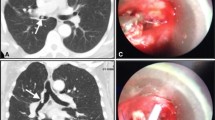Abstract
Purpose
Although bronchoscopy has conventionally been performed using conscious sedation, advanced diagnostic techniques like endobronchial ultrasound-guided transbronchial needle aspiration (EBUS-TBNA), peripheral EBUS, and electromagnetic navigational bronchoscopy add to procedural complexity. The adaptation of these techniques by bronchoscopists of varied backgrounds is expanding. It is not clear how patients will tolerate these advanced procedures when they are performed using traditional conscious sedation.
Methods
We prospectively studied patients that underwent diagnostic bronchoscopic procedures using conscious sedation over a 1-year period. The primary outcome was patient tolerability measured with four questions soliciting subjective responses. Secondary outcomes included required dosage of medications, thoroughness of the procedure, diagnostic yield, and occurrence of complications.
Results
A total of 181 patients were enrolled. Compared to patients in whom conventional bronchoscopy with transbronchial biopsies were performed, there was no difference in patient tolerability using the advanced techniques. Although some of the advanced procedures added to the procedure time, the required amount of medication was within commonly accepted dosages. When EBUS-TBNA was performed, a mean of 2.8 lymph node stations per patient were sampled. A specific diagnosis was obtained in 55.9 % of patients who solely underwent EBUS-TBNA. The diagnostic yield increased to 75.7 % when a parenchymal abnormality prompted additional biopsies. One patient required sedation reversal. Complications were minimal.
Conclusions
This study suggests that advanced diagnostic bronchoscopic procedures are well tolerated using conscious sedation with no compromise of thoroughness, diagnostic yield, or safety. This may be useful for bronchoscopists using these techniques who do not have ready access to general anesthesia.

Similar content being viewed by others
References
Wahidi MM et al (2011) American College of Chest Physicians consensus statement on the use of topical anesthesia, analgesia, and sedation during flexible bronchoscopy in adult patients. Chest 140(5):1342–1350
Eapen GA et al (2013) Complications, consequences, and practice patterns of endobronchial ultrasound-guided transbronchial needle aspiration. Chest 143(4):1044–1053
Hsia DW et al (2012) Diagnosis of lung nodules with peripheral/radial endobronchial ultrasound-guided transbronchial biopsy. J Bronchol Interv Pulmonol 19(1):5–11
Mohanasundaram U, Ho LA, Kuschner WG, Chitkara RK, Canfield J, Canfield LM, Krishna G (2013) The diagnostic yield of naviagational bronchoscopy performed with propofol deep sedation. ISRN Endosc. doi:10.5402/2013/824693
Stather DR et al (2013) Trainee impact on procedural complications: an analysis of 967 consecutive flexible bronchoscopy procedures in an interventional pulmonology practice. Respiration 85(5):422–428
Yasufuku K et al (2005) Endobronchial ultrasound guided transbronchial needle aspiration for staging of lung cancer. Lung Cancer 50(3):347–354
Ernst A et al (2008) Diagnosis of mediastinal adenopathy-real-time endobronchial ultrasound guided needle aspiration versus mediastinoscopy. J Thorac Oncol 3(6):577–582
Navani N et al (2012) Endobronchial ultrasound-guided transbronchial needle aspiration prevents mediastinoscopies in the diagnosis of isolated mediastinal lymphadenopathy: a prospective trial. Am J Respir Crit Care Med 186(3):255–260
Sharples LD et al (2012) Clinical effectiveness and cost-effectiveness of endobronchial and endoscopic ultrasound relative to surgical staging in potentially resectable lung cancer: results from the ASTER randomised controlled trial. Health Technol Assess 16(18):1–75 Iii–iv
Steinfort DP et al (2010) Cost-benefit of minimally invasive staging of non-small cell lung cancer: a decision tree sensitivity analysis. J Thorac Oncol 5(10):1564–1570
Steinfort DP et al (2011) Radial probe endobronchial ultrasound for the diagnosis of peripheral lung cancer: systematic review and meta-analysis. Eur Respir J 37(4):902–910
Memoli W, Memoli JS, Nietert PJ, Silvestri GA (2012) Meta-analysis of guided bronchoscopy for the evaluation of the pulmonary nodule. Chest 142(2):385–393
Lechtzin N et al (2002) Patient satisfaction with bronchoscopy. Am J Respir Crit Care Med 166(10):1326–1331
Steinfort DP, Irving LB (2010) Patient satisfaction during endobronchial ultrasound-guided transbronchial needle aspiration performed under conscious sedation. Respir Care 55(6):702–706
Lee HJ et al (2011) Pilot randomized study comparing two techniques of airway anaesthesia during curvilinear probe endobronchial ultrasound bronchoscopy (CP-EBUS). Respirology 16(1):102–106
Gotta AW, Sullivan CA (1981) Anaesthesia of the upper airway using topical anaesthetic and superior laryngeal nerve block. Br J Anaesth 53(10):1055–1058
Yarmus LB et al (2013) Comparison of moderate versus deep sedation for endobronchial ultrasound transbronchial needle aspiration. Ann Am Thorac Soc 10(2):121–126
Lee HS et al (2008) Real-time endobronchial ultrasound-guided transbronchial needle aspiration in mediastinal staging of non-small cell lung cancer: how many aspirations per target lymph node station? Chest 134(2):368–374
Wohlschlager J et al (2012) Rapid on-site evaluation (ROSE) in cytological diagnostics of pulmonary and mediastinal diseases. Pathologe 33(4):308–315
Acknowledgments
The authors would like to express gratitude to Anna Kookoolis, MA, for her ongoing contributions to patient enrollment and follow-up and for her diligence in data entry. This work was supported in part by the Claude D. Pepper Older Americans Independence Center at Yale University School of Medicine (2P30AG021342-06 for KLBA and TEM).
Conflict of interest
The authors declare that they have no conflict of interest.
Author information
Authors and Affiliations
Corresponding author
Rights and permissions
About this article
Cite this article
Goyal, G., Pisani, M.A., Murphy, T.E. et al. Advanced Diagnostic Bronchoscopy Using Conscious Sedation and the Laryngeal Nerve Block: Tolerability, Thoroughness, and Diagnostic Yield. Lung 192, 905–913 (2014). https://doi.org/10.1007/s00408-014-9607-4
Received:
Accepted:
Published:
Issue Date:
DOI: https://doi.org/10.1007/s00408-014-9607-4




